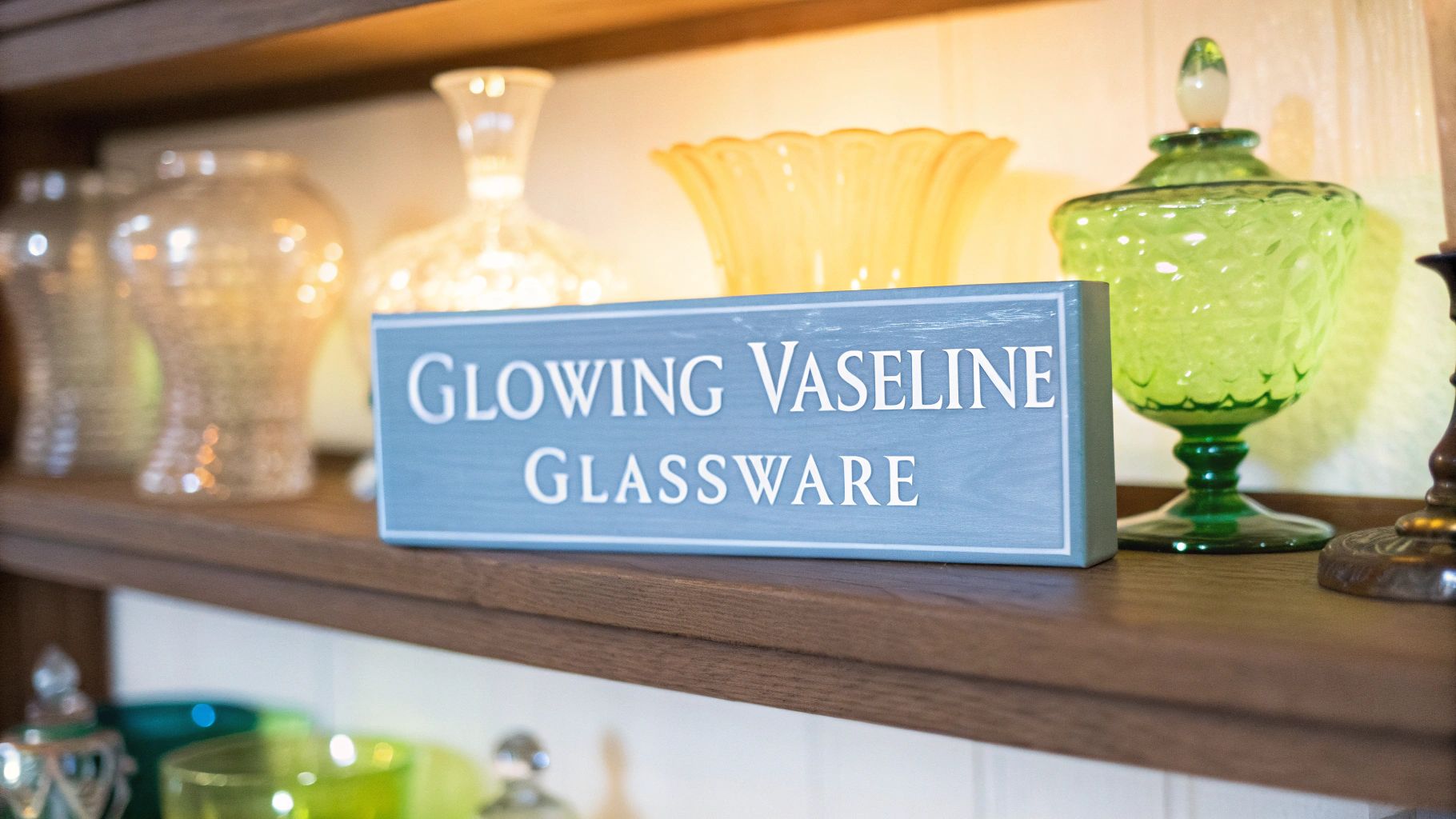Ever seen an antique glass dish, a pleasant yellow-green in the light, suddenly blaze with an almost supernatural green glow under a black light? That's the unmistakable magic of Vaseline glass. It gets its name from its color, which reminded people of the original petroleum jelly. But its famous glow? That comes from a tiny bit of uranium oxide mixed into the glass itself.
The Secret Behind the Glow
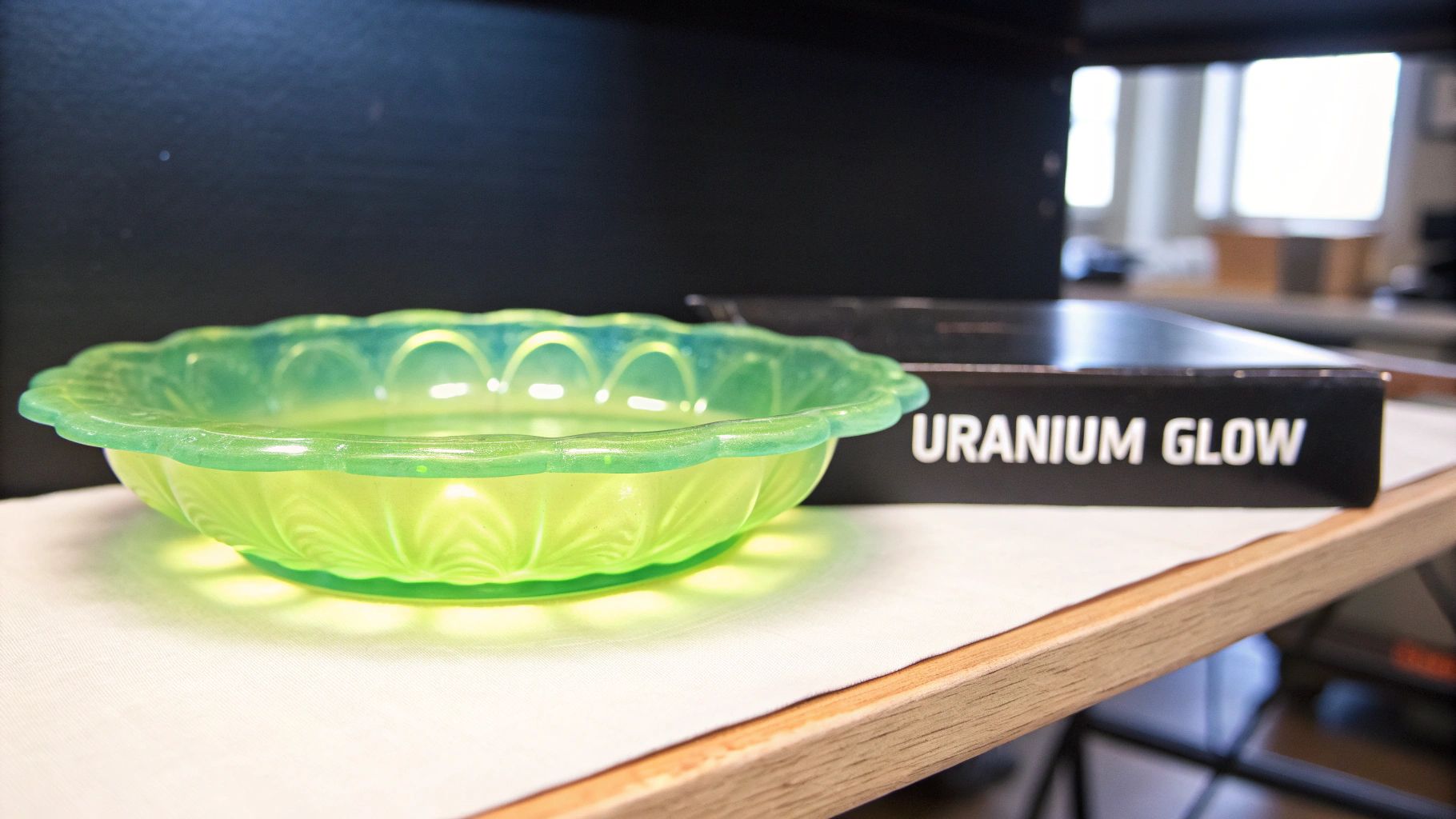
The secret ingredient that makes Vaseline glass so special is a tiny amount of uranium oxide—usually around 2% by weight—added to the molten glass during production. This isn't just for color; it's the key to its hidden superpower: fluorescence.
Think of the uranium inside the glass as a bunch of microscopic batteries. In normal light, they just sit there, soaking up a little energy. But hit them with an ultraviolet (UV) or "black" light, and they kick into high gear. They absorb that high-energy UV light and instantly spit it back out as visible light.
And that's where the glow comes from. It’s not a reflection or a paint on the surface. The light is literally coming from inside the glass, creating a brilliant, eerie effect that has fascinated collectors for nearly 200 years.
What Gives It That Specific Color?
That signature electric-green glow is a dead giveaway for uranium. Other elements, like manganese, can also make glass fluoresce, but they produce different colors, often a yellow or orange. If it's glowing that vibrant, almost neon green, you're looking at true Vaseline glass.
This unique quality is what turns a simple bowl or vase into a little piece of scientific history. It’s where art and atomic physics meet. The defining characteristics are pretty straightforward:
- Uranium Content: The non-negotiable ingredient for that tell-tale glow.
- A Unique Glow: An intense, bright green fluorescence under a UV light.
- Daylight Color: In regular light, it ranges from a pale canary yellow to a richer apple green.
Getting a handle on this basic science is the first step to truly appreciating these collectibles. Each piece is a tangible link to a bygone era when glassmakers weren't afraid to experiment with the elements.
The Surprising History of Uranium Glass
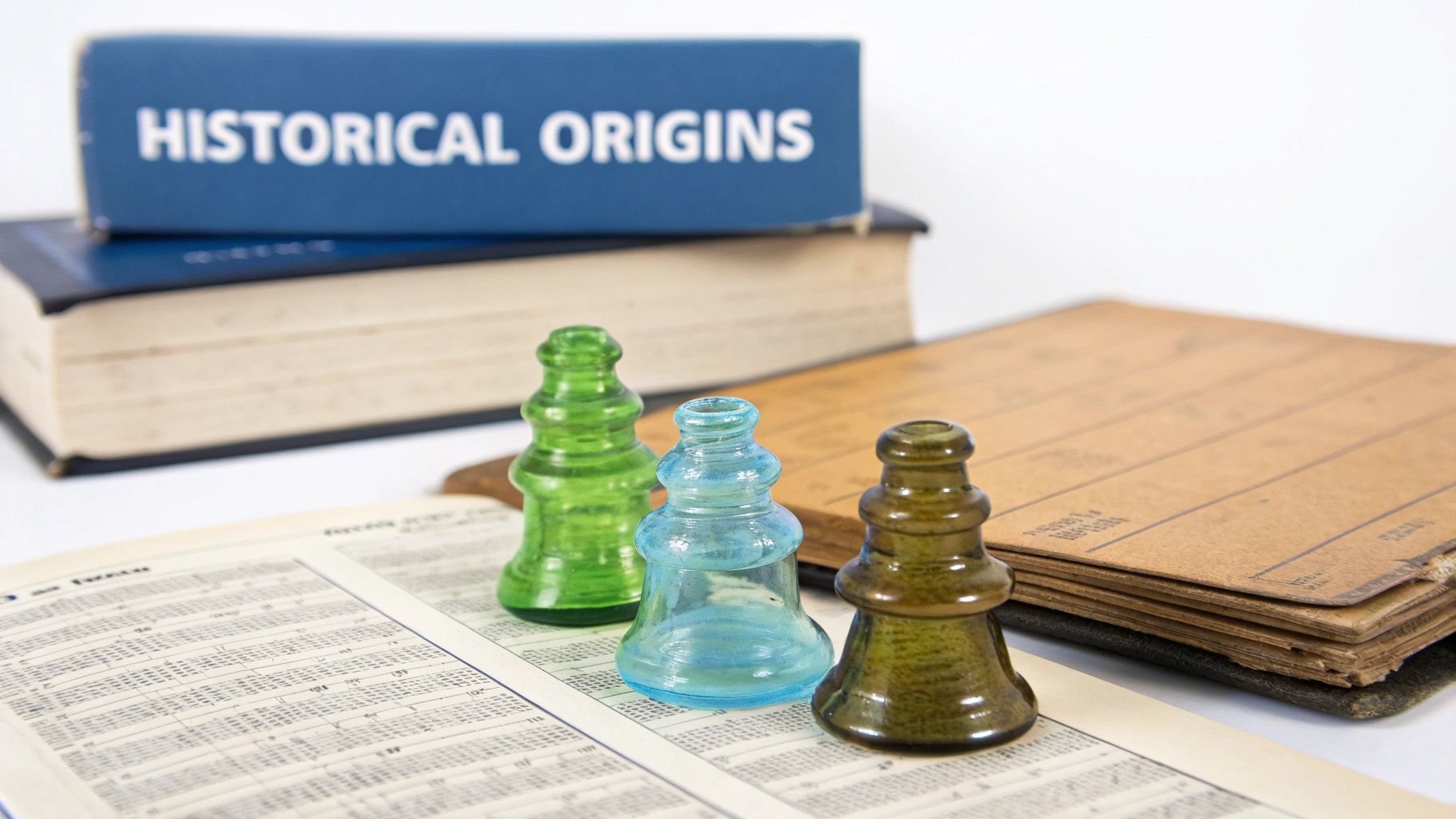
Long before anyone knew about radioactivity—let alone its famous green glow under a blacklight—the secret ingredient in antique vaseline glassware was used simply for its stunning color. The story of this glass doesn't start in a stuffy Victorian lab, but way back in the ancient world. It was a fascinating, accidental blend of geology and artistry.
Believe it or not, the earliest known use of uranium in glass goes back almost two thousand years. In 1912, archaeologists excavating a Roman villa near Naples, Italy, stumbled upon a mosaic from 79 AD. Tucked into the design were yellow glass tiles that, upon analysis, contained about 1% uranium oxide. The Roman artisans who made it likely had no clue what created the vibrant color; they just knew it worked. You can read more about this incredible archaeological find on Wikipedia.
After that, the technique seems to have vanished for centuries. The story picks up again in the 1830s, when the secret of uranium was not just rediscovered but turned into a commercial success.
The Bohemian Renaissance of Uranium Glass
This revival was led by a Bohemian glassmaker named Josef Riedel. He figured out how to use uranium to create brilliantly colored glass that was both stable and beautiful. He even named his two signature colors after his wife, Anna, and they became the benchmark for vaseline glass.
These two iconic colors were:
- Annagrün (Anna Green): A striking, transparent green that just danced in the light.
- Annagelb (Anna Yellow): A bright, sunny yellow that gave the glass its signature look.
Riedel’s timing was perfect. For years, Georgian-era glassmakers in England had been trying and failing to make a reliable, vibrant green glass. Riedel's formula was the answer they were looking for, and it kicked off a craze for this unique material that quickly swept across Europe and into America.
What’s so fascinating is that for the first hundred years of its popularity, people loved vaseline glass just for how it looked in daylight. Its famous, eerie glow under ultraviolet light was a complete accident—a hidden secret that would only add to its mystique for future collectors.
This early chapter shows that the appeal of antique vaseline glassware was originally all about aesthetics. The radioactive glow that we associate with it today was just a hidden bonus, waiting to be discovered and add another layer to its incredible story.
How To Identify Authentic Vaseline Glass
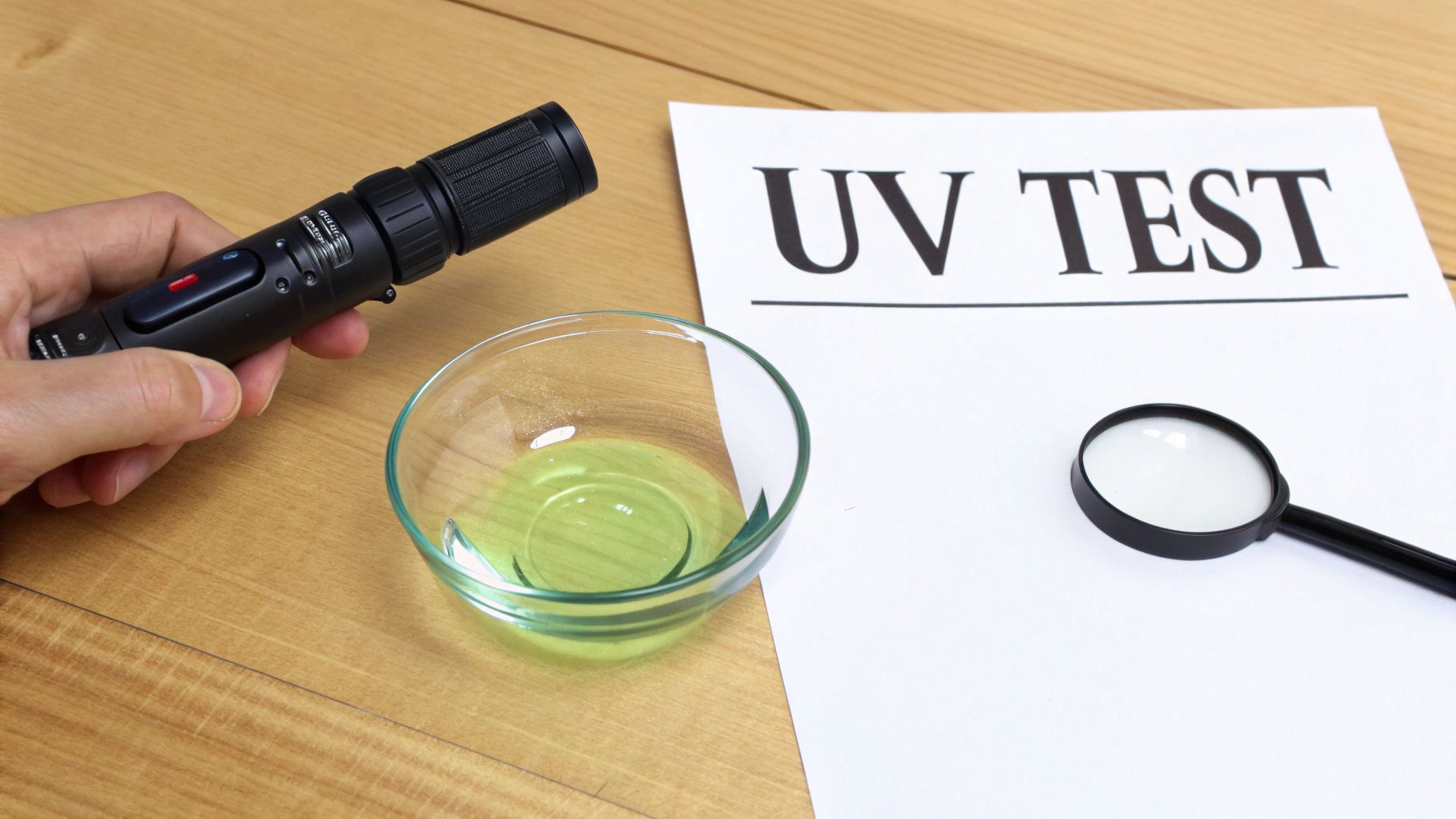
Spotting a genuine piece of antique vaseline glassware can feel like a real-life treasure hunt. The good news is, you don't need a map—just a bit of know-how and one essential tool. With the right approach, you can learn to confidently tell a glowing artifact from a clever imitation.
The single most important item in your identification toolkit is a simple ultraviolet (UV) or black light. This is the definitive test. When you shine a UV light on true vaseline glass, the uranium oxide inside it will light up with a brilliant, almost electric green glow. It’s not a subtle effect; it’s a vibrant, unmistakable reaction.
If there's no glow, it's not vaseline glass. Period. Think of the black light as the secret key that reveals the glass's true identity.
What To Look For in Daylight
Before you even reach for your black light, your own eyes can give you some big clues. In normal daylight, authentic vaseline glass has a very distinct look. Its color should fall somewhere in the range of a pale canary yellow to a richer, almost oily-looking yellow-green.
That slightly greasy sheen is actually what inspired the "vaseline" nickname in the first place. Seeing that subtle visual texture is often the first sign you might be holding something special. For a broader overview of glass identification, our guide on identifying antique glassware has some great additional tips.
Remember, though, that visual cues are just a starting point. Plenty of old glass comes in shades of yellow and green, so you'll always need to confirm your suspicions with the black light test.
Distinguishing The Glow
Here’s where things can get a little tricky: not all glass that glows under a black light is vaseline glass. Other additives can also fluoresce, easily fooling an untrained eye. The real skill is learning to recognize the specific color and intensity of the glow.
The glow from true antique vaseline glassware is a sharp, vivid lime or electric green. This is the classic signature of its uranium content. Other materials, like manganese, can make glass glow too, but the color is usually a much duller yellow or even a peachy-orange.
Getting familiar with the different types of glowing glass is crucial to avoid common mix-ups. This table breaks down what to look for.
Vaseline Glass Identification Guide
| Glass Type | Daylight Color | UV Fluorescence Color | Key Distinguishing Feature |
|---|---|---|---|
| Vaseline Glass | Pale yellow to yellow-green | Bright, electric green | The unmistakable and intense green glow is its primary identifier. |
| Manganese Glass | Clear, purple, or pinkish | Dull yellow-green or orange | Often found in decolorized glass; the glow is much weaker. |
| Burmese Glass | Opaque yellow and pink | Bright yellow-green | A specific type of art glass with a creamy, two-tone appearance. |
| Custard Glass | Opaque, creamy yellow | Bright greenish-yellow | An opaque glass that contains uranium, similar but not identical to vaseline. |
Understanding these subtle differences is what separates a novice from an informed collector. By combining a quick visual check in daylight with the definitive black light test, you can confidently identify authentic antique vaseline glassware and build your collection with certainty.
The Rise and Fall of Its Popularity
The story of Vaseline glass is a classic tale of changing tastes and new technology. Its journey from a scientific wonder to a treasured collectible is fascinating, starting with its boom in the Victorian era. At a time of incredible industrial and scientific leaps, that otherworldly glow was more than just a novelty—it was a symbol of progress.
Victorian England, especially, fell in love with uranium glass. These glowing objects were tangible proof of humanity's growing mastery over the mysterious forces of nature. The way it fluoresced under ultraviolet light captured the imagination of everyone from artisans to the general public, sparking an interest that has lasted for nearly two centuries.
This initial craze wasn't just a flash in the pan. The glass's bold, vibrant color carried it right into the Art Deco period. Its geometric elegance and striking presence fit the era's aesthetic perfectly, making it a staple in any stylish, modern home.
The Lights Go Out on the Glow
So what happened? Why did this glowing sensation fade from the limelight? The most compelling theory is that the very thing it once represented—technological progress—was also its downfall. The culprit? Electric lighting.
Picture a piece of Vaseline glass on a windowsill in a home lit by gas lamps or the soft glow of a sunset. It would come alive with an enchanting, almost magical light. But the harsh, consistent glare of an electric bulb completely washed out that subtle effect, killing the very magic that had charmed people in the first place. You can dive deeper into this fascinating clash of technology and taste by reading about that subtle uranium glow on nts.org.uk.
The story of Vaseline glass is a perfect reminder of how our surroundings shape what we find beautiful. The context that made it magical simply vanished, and its widespread popularity went with it.
A Glowing Modern Renaissance
Even though it fell out of fashion for decades, the story wasn't over. In recent years, antique Vaseline glass has made a huge comeback, fueled by collectors who are drawn to its rich history, unique look, and the science behind it.
Today, collectors seek it out not just for how it looks in daylight, but for the very glow that once went out of style. This revival shows how much we've come to appreciate craftsmanship, history, and a real connection to a time gone by.
Modern collectors are all about the story behind each piece. They hunt for specific makers and eras, building collections that celebrate the glass's entire journey. It just goes to show that true beauty and historical weight never really fade away—sometimes they just need a new generation to see the magic. That glow, once snuffed out by modern light, is now revealed on purpose with handheld black lights, bringing its secret world back into view.
How to Value and Collect Antique Vaseline Glassware
So, you're ready to start hunting for your own glowing treasures? Welcome to the club! But before you start buying, it helps to know what you're looking at. Like any antique, the value of a piece of Vaseline glass comes down to a few key things. Think of it as putting together a puzzle—you need to consider the maker, the pattern, its condition, and just how brilliantly it glows.
The maker's mark is like an artist's signature. Well-known names like Fenton, Mosser, and Heisey are a big deal in the collecting world because they were known for top-notch quality and beautiful designs. An item with a clear maker’s mark is almost always worth more than a mystery piece, giving it a solid place in history. It's one of the main reasons some items end up being among the most valuable antique glassware on the market.
Pattern and rarity are just as important. Some designs were made by the thousands for years on end, so they’re pretty common. Others were only produced for a very short time, making them the white whales for collectors. If you stumble upon a complex or unusual pattern from a limited run, you've likely found something special.
Key Factors for Valuation
When you’re out in the wild—whether at a dusty antique shop or a weekend flea market—keep these four things in your mind. Getting a handle on them will help you spot the real gems and make smarter choices for your collection.
Condition Is Everything: Look over every potential piece like a detective. Are there chips, cracks, or deep scratches? Is the glass "sick," meaning it has a permanent cloudy film? A piece in perfect, or "mint," condition is the gold standard. Even a tiny chip can slash the value by 50% or more, so be picky.
Color and Glow Intensity: All Vaseline glass glows, but not all glows are created equal. The most sought-after pieces have a rich, consistent yellow-green color in normal light and an intense, almost electric glow under a blacklight. A weak glow or a pale daytime color can make a piece less desirable.
Maker and Provenance: We've touched on the maker, but provenance—the piece's history of ownership—can also add a surprising amount of value. If you can prove an item came from a famous collection, its story becomes part of its worth.
Form and Function: Let's face it, some items are just more common than others. You'll see tons of small saucers and simple plates. But a complete punch bowl set, a large, ornate centerpiece, or a quirky figural piece? Those are much harder to come by and, you guessed it, much more valuable.
Strategies for Starting Your Collection
Jumping in can feel like a lot at once, so it’s best to start with a plan. Instead of grabbing any glowing piece you see, try to focus your efforts. You could decide to collect only pieces from a single company, like Gillinder & Sons, or maybe you'll fall in love with a specific pattern. Some people even specialize in just one type of item, like salt cellars or pitchers.
A focused collection tells a more cohesive story and often becomes more valuable as a set than the sum of its individual parts. It transforms you from a buyer into a true curator.
The glass world is incredibly diverse, from the radioactive glow of uranium glass to the intricate beauty of Murano Millefiori paperweights. No matter where your treasure hunt takes you, keeping these basics in mind will help you build a collection that’s not only a joy to look at but a sound investment, too.
Caring For Your Glowing Collection
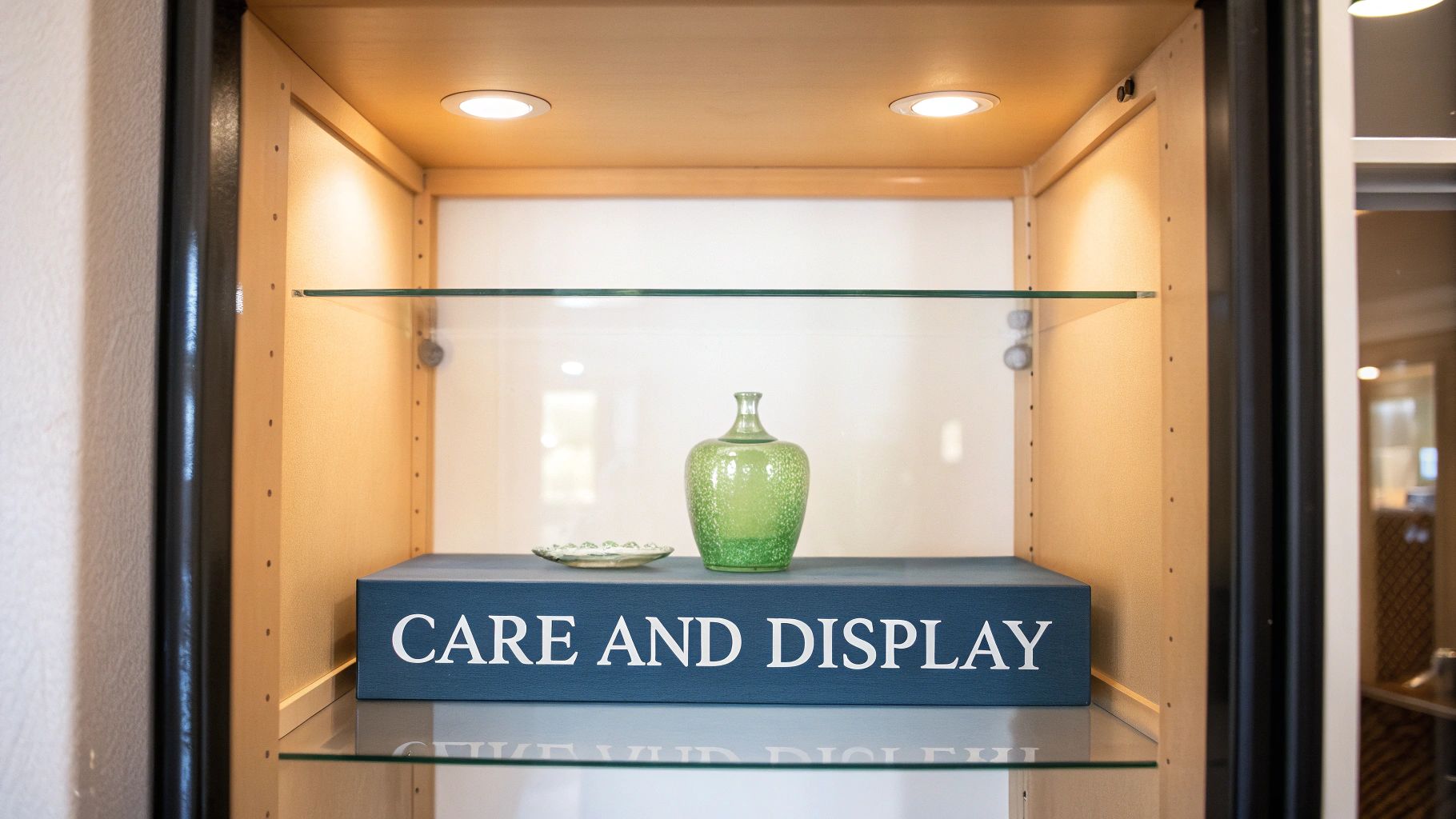
So, you've started a collection of this glowing glassware. Now, how do you keep it looking its best? Properly caring for your antique vaseline glassware is the key to preserving its beauty and, of course, its value.
First, let's address the elephant in the room: the word "uranium." While it sounds a bit intense, the radiation levels in these pieces are incredibly low and considered perfectly safe for handling and display.
That said, it’s best to keep these antiques out of the kitchen cabinet. Modern safety advice is clear: don't use them for serving food or drinks. It's a fun historical note that after WWII, glassmakers switched to depleted uranium, and any modern pieces are purely for decoration. You can read more about this shift over at the ORAU Health Physics Museum.
Gentle Cleaning and Handling
When it comes to cleaning, think "less is more." These pieces are delicate, and a sudden change in water temperature can cause thermal shock, leading to a heartbreaking crack. Always stick with lukewarm water and a very mild soap.
Pro Tip: Your dishwasher is the enemy of antique glass. So are harsh chemical cleaners. They can permanently etch the surface, leaving it cloudy and significantly reducing its value.
If you want a more detailed walkthrough, many of the same principles apply across all antique glass. Our guide on how to clean an old glass bottle has some great techniques you can use.
Smart and Safe Display
Half the fun of collecting Vaseline glass is showing off that signature glow! A curio cabinet, especially one with a built-in UV light, is the perfect stage. It not only creates a stunning display but also protects your treasures from dust and accidental bumps.
For more great ideas on keeping your collection in mint condition, check out these proven tips for storing collectibles. A little bit of care goes a long way in making sure your pieces stay brilliant for years to come.
Common Questions About Vaseline Glass
Diving into the world of antique vaseline glassware always brings up a few key questions, especially when you're just starting out. Getting good, clear answers is the best way to feel confident as you start hunting for these glowing treasures.
Let's tackle some of the things people wonder about the most.
Is It Safe To Own and Handle?
Yes, it's generally considered perfectly safe to handle and display. The amount of uranium in any given piece is tiny—usually around 2%—and the radiation it gives off is mostly alpha particles, which are so weak they can't even get through your skin.
That said, the common wisdom among collectors and health experts is to avoid using it for food or drinks. This is really just a better-safe-than-sorry precaution, as there’s a slim chance that something acidic could leach a trace amount of uranium out of the glass. For keeping it in a display case and handling it, the risk is practically zero.
In short: Look, but don't eat. Think of your collection as beautiful art to be admired, not as your everyday dinnerware, and you can enjoy it without a second thought.
Does All Old Yellow or Green Glass Glow?
Definitely not, and this is probably the most important thing to learn when identifying it. Other elements, like manganese, were sometimes added to glass and can make it fluoresce under a UV light, but the glow just isn't the same.
True vaseline glass has an unmistakable, brilliant, almost electric green glow. That signature fluorescence is its real calling card. Other materials might glow a dull yellow, a faint orange, or a weak, murky green. Learning to recognize the specific, vibrant glow of uranium is the best skill you can develop for spotting the real deal.
Vaseline Glass vs. Depression Glass
This one trips up a lot of people! The confusion is understandable, but the difference is actually pretty simple. It all comes down to what defines them:
- Vaseline Glass is all about its chemical makeup. To be called vaseline glass, it absolutely must contain uranium oxide, which gives it that classic color and glow.
- Depression Glass is defined by its era. This term refers to the colorful, mass-produced glassware made during the Great Depression, from about the 1920s through the 1940s.
So, can a piece be both? You bet! A good amount of green or yellow Depression glass was made with uranium, making it vaseline glass, too. But remember, not all Depression glass is vaseline glass, and not all vaseline glass comes from the Depression era. One is a material, and the other is a historical period.
Ready to uncover the story behind your own finds? The Curio app makes it easy. Just snap a photo to instantly identify antiques, learn their history, and get an estimated value. Download Curio today and turn your curiosity into expertise: https://www.curio.app
